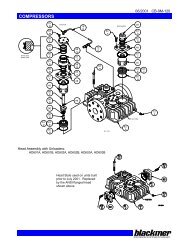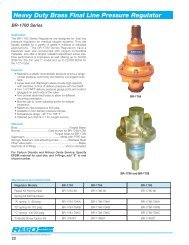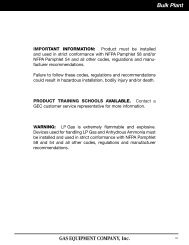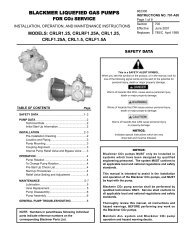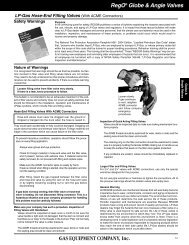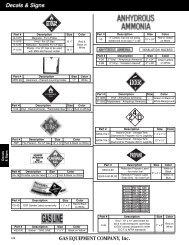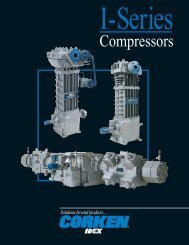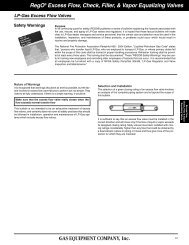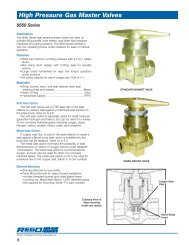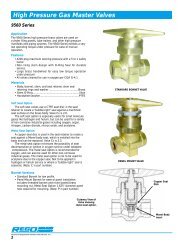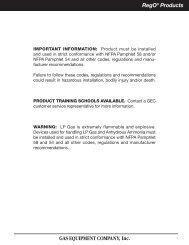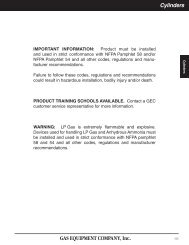RegO® Cylinder & Service Valves - Gas Equipment Company, Inc.
RegO® Cylinder & Service Valves - Gas Equipment Company, Inc.
RegO® Cylinder & Service Valves - Gas Equipment Company, Inc.
You also want an ePaper? Increase the reach of your titles
YUMPU automatically turns print PDFs into web optimized ePapers that Google loves.
RegO ® Internal <strong>Valves</strong> & Accessories<br />
LP-<strong>Gas</strong> Internal <strong>Valves</strong><br />
Safety Warning<br />
Purpose<br />
In its continuing quest for safety, Engineered Controls International, <strong>Inc</strong>. publishes a series of bulletins<br />
explaining the hazards associated with the use, misuse, and aging of LP-<strong>Gas</strong> valves and regulators. It is<br />
hoped that these factual bulletins will make clear to LP-<strong>Gas</strong> dealer managers and service personnel, that<br />
the utmost care and attention must be used in the installation, inspection, and maintenance of these products,<br />
or problems could occur which would result in injuries and property damage.<br />
The National Fire Protection Association Pamphlet #58, “Storage and Handling of Liquified Petroleum<br />
<strong>Gas</strong>es’’ states in section 1-6 that “In the interest of safety, all persons employed in handling LP-<strong>Gas</strong>es shall<br />
be trained in proper handling and operating procedures’’. These “ECII ® Safety Warnings’’ may be useful in<br />
training new employees and reminding older employees of hazards that can occur.<br />
It is recommended that all employees be furnished with a copy of NPGA Safety Pamphlet 306-88 “LP-<strong>Gas</strong><br />
Regulator and Valve Inspection and Maintenance, 111-81 Limitations of Excess Flow Check <strong>Valves</strong> for LP-<br />
<strong>Gas</strong>, and 113-78 Safety Considerations in Bobtail Deliveries.’’<br />
Nature of Warnings<br />
It is recognized that warnings should be as brief as possible, but the factors<br />
involved in internal valve and excess flow valve failures to perform<br />
are not simple. They need to be fully understood. If there is a simple<br />
warning, it would be:<br />
Make sure that the internal valve’s excess flow feature really<br />
closes when the flow exceeds rated closing flow, and that the<br />
valve will shut-off.<br />
This bulletin is not intended to be an exhaustive treatment of internal<br />
valves, and certainly does not cover all safety practices that should be<br />
followed in installation, operation and maintenance of LP-<strong>Gas</strong> systems,<br />
which include internal valves.<br />
Internal valves must be closed on Cargo Vehicles when traveling on<br />
public roads and highways. The valve should only be open when<br />
pumping. Per MC 330 or 331, internal valves must also be equipped<br />
with remote closure system, when used on transports or bobtails.<br />
There are two types of internal valves being used on storage tanks,<br />
transports and bobtails — spring loaded internal valves and differential<br />
pressure internal valves. They both provide positive shut-off when product<br />
is not being withdrawn and may include excess flow protection for<br />
the system during transfer operations.<br />
Spring Loaded Internal <strong>Valves</strong><br />
Spring loaded internal valves are manually opened by levers, by means<br />
of fuse linked cable mechanisms or pneumatic or hydraulic actuators.<br />
They incorporate an excess flow feature that will close the valve when the<br />
flow through the valve exceeds its rate of flow. These valves should<br />
never be locked open by means of wires, chains, pegs or other<br />
devices.<br />
Testing<br />
Testing should be completed on a periodic basis.<br />
1. To check operation of a spring loaded valve, activate the remote<br />
control to close the valve while unit is pumping. If the meter indicator<br />
flow continues, the valve should be repaired immediately.<br />
2. Testing excess flow feature.<br />
The National Propane <strong>Gas</strong> Association Safety Bulletin #113-78<br />
states: “In order to test an excess flow valve in a piping system, the<br />
flow through the valve must be made to exceed the valve’s closing<br />
rating.’’<br />
This testing should only be attempted by trained personnel familiar<br />
with the process. If no one at the facility has experience in<br />
proper testing, outside expert help should be obtained.<br />
The exact procedure used may vary with the installation, advisability<br />
of gas discharge and availability of equipment.<br />
In general, most testing makes use of the fact that the excess flow<br />
valves are “surge sensitive’’ and will close quicker under a sudden<br />
flow surge than under steady flow. A sufficient surge can often be<br />
created by using a quick open/close valve to control sudden,<br />
momentary flow into a tank or piping section containing very low<br />
pressure. An audible click from the excess flow valve (and corre-<br />
72



